4. Parada Cardíaca
Quando o coração pára de bombear sangue para o organismo, as
células deixam de receber oxigênio. Existem órgãos que resistem vivos, até
algumas horas, porém, os neurônios do sistema nervoso central (SNC) não suportam
mais do que seis minutos sem serem oxigenados e entram em processo de necrose.
Desta forma, a identificação e a recuperação cardíaca devem ser feitas de
imediato. Caso haja demora na recuperação cardíaca, o SNC pode sofrer lesões
graves e irreversíveis, e a vítima pode, até mesmo, morrer.
4.1. Identificação
- Inconsciência
- Ausência de respiração
- Ausência de circulação
4.2. Tratamento
O socorrista deverá iniciar a massagem cardíaca externa o mais
cedo possível.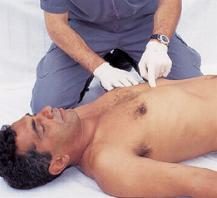 Para realizá-la
deve:
Para realizá-la
deve:
- Localizar o apêndice xifóide com o dedo indicador da mão esquerda.
Colocar dois dedos da mão direita ao lado do indicador da mão esquerda.
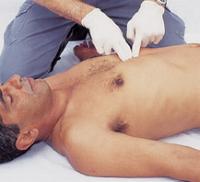
-
Após colocar os dois dedos, posicionar a palma da mão
esquerda.
- Posicionar a mão direita sobre a mão esquerda, cruzando os dedos.
Os ombros do socorrista devem estar paralelos ao osso
esterno da
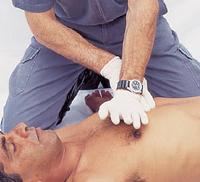 vítima e os seus
braços estendidos totalmente.
vítima e os seus
braços estendidos totalmente.
Somente a região hipotenar da palma da mão toca o esterno da
vítima, evitando-se, dessa forma, pressionar as costelas.
Em consequência da massagem,o esterno, em vítima adultas,
deverá ser deslocado para baixo entre 4 e 5 cm.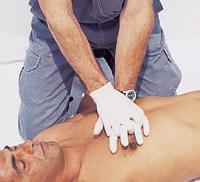
Em crianças, com idade entre 1 a 8 anos, a pressão deve ser
exercida com apenas uma das mãos, e o esterno deve ser deslocado entre 2,5 a 4
cm.
Em bebês, com idade variando de 0 a 1 ano, a pressão é
realizada com dois dedos, posicionando-os na intersecção do osso esterno com uma
linha imaginária ligando os mamilos, fazendo o esterno ser deslocado de 1 a 2,5
cm. 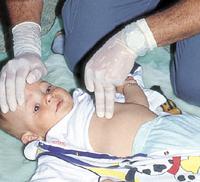
Nos casos de parada respiratória e cardíaca simultâneas,
deve-se intercalar a respiração artificial com a massagem cardíaca, método
conhecido como Reanimação Cardio-Pulmonar ou RCP, do seguinte modo:
CONFORME A GUIDELINES2005 DA ASSOCIAÇÃO AMERICANA DO CORAÇÃO
- Adulto - 2 ventilações por 30 massagens de 100
vezes por minuto. Para cada insuflação de 1 segundo até a expansão torácica se completar.
- Recem-nascidos(até 1 mês) e Crianças (até 1 ano) - Veja o que diz a GuideLines2005:
Para Infanto ou Criança, a procedidente do resgatador segue
a seguintes ações:
- O Resgatador abrirá as vias aéreas e checará a respiração,
se não houver resposta, o resgatador poderá aplicar duas insuflação até verificar a elevação do tórax.
- Se verificar a ausência de Pulso o Resgatador poderá aplicar a RCP(30
compressão e 2 respiração em 5 ciclos).
4.3.Não Ocorre RCP em Casos de sinais evidentes:
decapitação
calcinação
putrefação
rigidez cadavérica
manchas hipostáticas
TEXTO ORIGINAL
http://circ.ahajournals.org/cgi/content/full/112/24_suppl/IV-12?maxtoshow=&HITS=10&hits=10&RESULTFORMAT=&fulltext=infants+newborn+CPR&searchid=1&FIRSTINDEX=0&resourcetype=HWCIT
Sequence
If more than one person is present at the scene
of a cardiac arrest, several actions can occur simultaneously. One or
more trained rescuers should remain with the victim to begin the
steps of CPR while another bystander phones the emergency
response system and retrieves an AED (if available). If a lone
rescuer is present, then the sequences of actions described below
are recommended. These sequences are described in more detail in
Part 4: "Adult Basic Life Support," Part 5: "Electrical Therapies,"
and Part 11: "Pediatric Basic Life Support."
For the unresponsive adult, the lay rescuer sequence of action
is as follows:
- The lone rescuer should telephone the emergency response
system and retrieve an AED (if available). The rescuer
should then return to the victim to begin CPR
and use the AED when appropriate.
- The lay rescuer should open the airway and check for normal
breathing. If no normal breathing is detected, the rescuer
should give 2 rescue breaths.
- Immediately after delivery of the rescue breaths, the
rescuer should begin cycles of 30 chest compressions and 2
ventilations and use an AED as soon as it is
available.
For the unresponsive infant or child, the lay rescuer sequence
for action is as follows:
- The rescuer will open the airway and check for breathing; if
no breathing is detected, the rescuer should give 2
breaths that make the chest rise.
- The rescuer should provide 5 cycles (a cycle is 30
compressions and 2 breaths) of CPR
(about 2 minutes) before leaving the pediatric victim to
phone 911 and get an AED for the child if available. The
reasons for immediate provision of CPR
are that asphyxial arrest (including primary respiratory
arrest) is more common than sudden cardiac arrest in
children, and the child is more likely to respond to, or
benefit from, the initial CPR.
In general, the rescue sequence performed by the healthcare
provider is similar to that recommended for the lay rescuer,
with the following differences:
- If the lone healthcare provider witnesses the sudden
collapse of a victim of any age, after verifying that the
victim is unresponsive the provider should first phone 911
and get an AED if available, then begin CPR and use the AED as appropriate.
Sudden collapse is more likely to be caused by an
arrhythmia that may require shock delivery.
- If the lone healthcare provider is rescuing an unresponsive
victim with a likely asphyxial cause of arrest (eg, drowning),
the rescuer should provide 5 cycles (about 2 minutes) of CPR (30 compressions and 2
ventilations) before leaving the victim to phone the emergency
response number.
- As noted above, the healthcare provider will perform some
skills and steps that are not taught to the lay
rescuer.
 Para realizá-la
deve:
Para realizá-la
deve: Para realizá-la
deve:
Para realizá-la
deve:
 vítima e os seus
braços estendidos totalmente.
vítima e os seus
braços estendidos totalmente.
